Power electronic handbook
Подождите немного. Документ загружается.

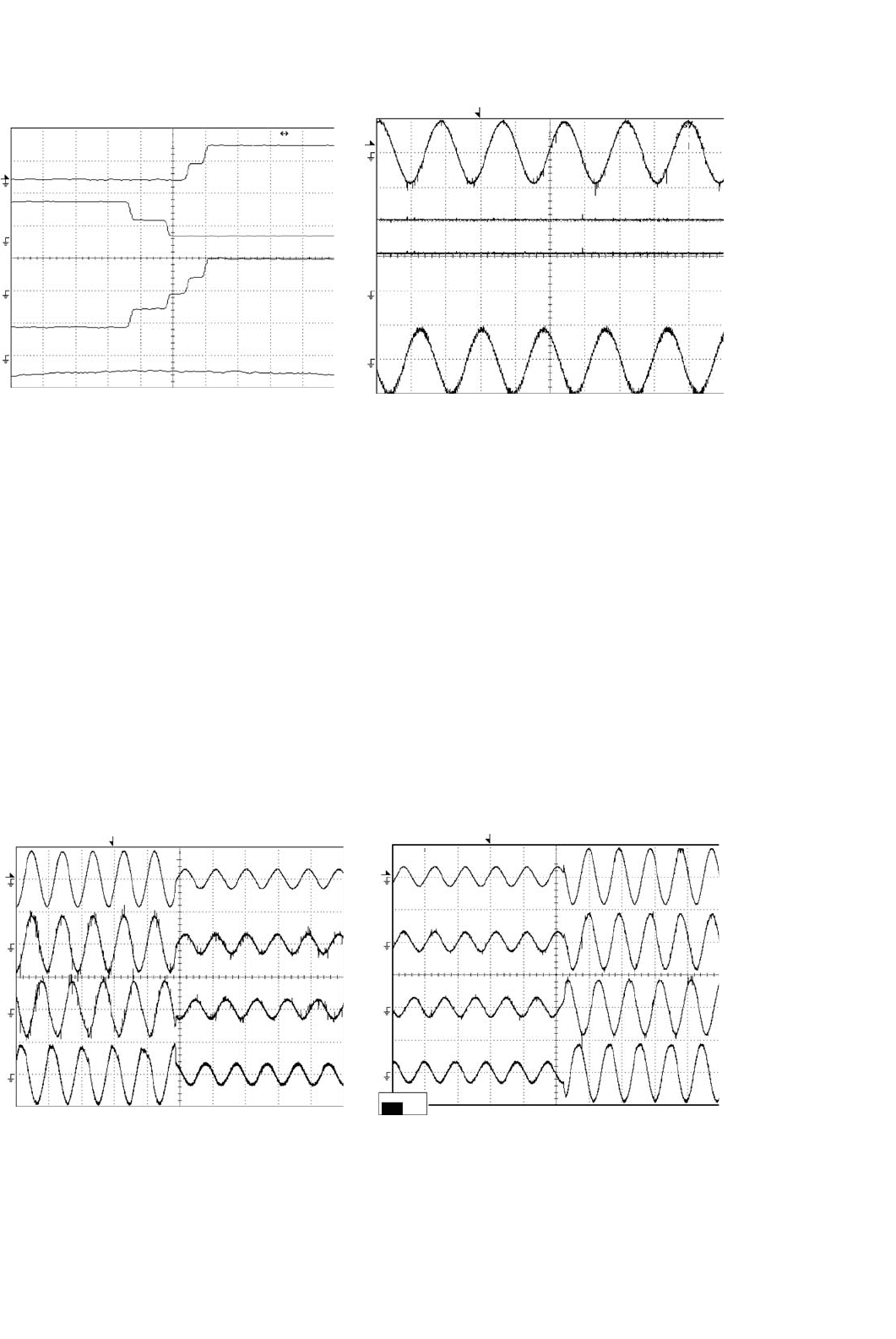
34 Control Methods for Switching Power Converters 987
3
4
2
1
T
4
2
1
T
T
U
1
U
13
U
3
i
3
u
ref
U
C1
+U
C2
U
C2
i
3
(a) (b)
CH1 = 50 V
CH2 = 50 V
3:Math
1-2
CH4 = 20 mV
DC
10:1
DC
10:1
DC
1:1
1999/11/26 20:37:07
1999/11/26 19:44:04
Stopped
Stopped
NORM: 1MS/s
20us / div
NORM:200 kS/s
5 ms / div
(5 ms / div)
CH1 = 2 V
DC 10:1
CH2 = 50 V
DC 10:1
CH3 = 50 V
DC 10:1
CH4 = 20 mV
DC 1:1
FIGURE 34.62 Experimental results showing (a) the transitions between adjacent voltage levels (50 V/div; time 20 µs/div) and (b) performance of
the capacitor voltage equalizing strategy; from top trace to bottom: 1 is the voltage reference input; 2 is the power supply voltage; 3 is the mid-point
capacitor voltage, which is maintained close to U
dc
/2; 4 is the output current of phase 3(2 A/div; 50 V/div; 5 ms/div).
three-phase currents. Figure 34.63b shows almost the same
test (step response from 2 to 4 A at the same frequency),
but now the power supply is set at 50 V and the induc-
tive load was unbalanced (±30% on resistor value). The
response remains virtually the same, with tracking ability,
almost no current distortions due to dead times or semicon-
ductor voltage drops. These results confirm experimentally
that the designed controllers are robust concerning these
nonidealities.
Stopped Stopped
OFF
i
ref
i
1
i
3
i
2
1999/11/20 17:51:13 1999/11/20 17:39:43
NORM.50 ks/s
Mem
ON
CH1 = 5 V
CH2 = 5 V
CH3 = 5 V
CH4 = 20 mV 20 ms / div
(20 ms / div)
NORM.50 kS/s
20 ms / div
(20 ms / div)
DC
10:1
CH1 = 5 V
DC 10:1
CH2 = 5 V
DC 10:1
CH3 = 5 V
DC 10:1
DC 10:1
DC 10:1 DC 1:1
CH4 = 20 mV
DC 1:1
4
3
2
1
T
4
3
2
1
T
T
i
ref
i
1
i
3
i
2
(
a
)(
b
)
FIGURE 34.63 Step response of the current control method: (a) step from 4 to 2 A. Traces show the reference current for phase 1 and the three
output currents with 150 V power supply (5 A/div; time scale 20 ms/div) and (b) step from 2 to 4 A in the reference amplitude at 52 Hz. Traces show
the reference current for phase 1 and the three output currents with 50 V power supply.
EXAMPLE 34.17 Sliding-mode vector controllers for
matrix converters
Matrix converters are all silicon ac/ac switching convert-
ers, able to provide variable amplitude almost sinusoidal
output voltages, almost sinusoidal input currents, and
controllable input power factor [18]. They seem to be
very attractive to use in ac drives speed control as well as
in applications related to power-quality enhancement.
The lack of an intermediate energy storage link, their
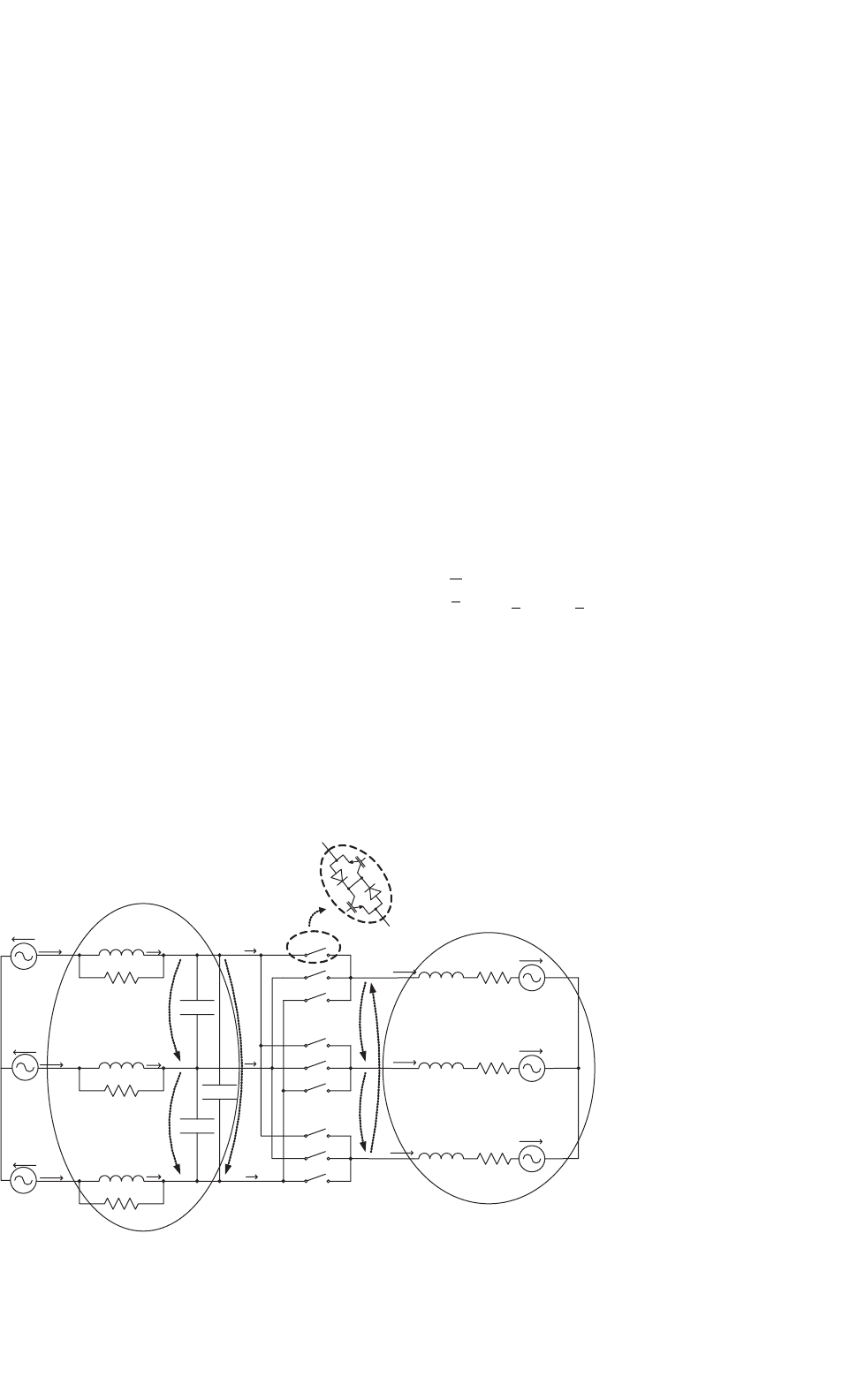
988 J. F. Silva and S. F. Pinto
main advantage, implies an input/output coupling which
increases the control complexity.
This example presents the design of sliding-mode con-
trollers considering the switched state-space model of the
matrix converter (nine bidirectional power switches),
including the three-phase input filter and the output
load (Fig. 34.64).
34.3.5.19 Output Voltage Control
Ideal three-phase matrix converters are obtained by assem-
bling nine bidirectional switches, with the turn-off capability,
to allow the connection of each one of the input phases to
any one of the output phases (Fig. 34.64). The states of these
switches are usually represented as a nine-element matrix S
(Eq. (34.171)), in which each matrix element, S
kj
k, j ∈
{1, 2, 3}, has two possible states: S
kj
= 1 if the switch is
closed (ON) and S
kj
= 0 if it is open (OFF). Only 27 switch-
ing combinations are possible (Table 34.6), as a result of
the topological constraints (the input phases should never
be short-circuited and the output inductive currents should
never be interrupted), which implies that the sum of all the
S
kj
of each one of the matrix, k rows must always equal 1
(Eq. (34.171)).
S =
S
11
S
12
S
13
S
21
S
22
S
23
S
31
S
32
S
33
3
j=1
s
kj
= 1 k, j ∈
{
1, 2, 3
}
(34.171)
Based on the matrix S, the output phase v
A
, v
B
, v
C
and line
voltages v
AB
, v
BC
, v
CA
, can be expressed in terms of the input
i
ia
l
i
ib
i
ic
v
ic
v
ib
v
ia
C
C
C
i
a
ib
i
c
S
11
LR
i
A
i
B
i
C
A
B
C
r
v
ca
S
12
S
13
S
21
S
22
S
23
S
31
S
32
S
33
v
CA
v
AB
v
BC
v
bc
l
r
l
r
i
la
i
lb
i
lc
L
R
LR
E
C
E
B
E
A
General RLE load
Input filter
v
ab
FIGURE 34.64 AC/AC matrix converter with input lCr filter.
phase voltages v
a
, v
b
, v
c
. The input currents i
a
, i
b
, i
c
can be
expressed as a function of the output currents i
A
, i
B
, i
C
:
v
A
v
B
v
C
= S
v
a
v
b
v
c
;
v
AB
v
BC
v
CA
=
S
11
−S
21
S
12
−S
22
S
13
−S
23
S
21
−S
31
S
22
−S
32
S
23
−S
33
S
31
−S
11
S
32
−S
12
S
33
−S
13
v
a
v
b
v
c
;
i
a
i
b
i
c
= S
T
i
A
i
B
i
C
(34.172)
The application of the Concordia transformation [X
α,β,0
]
T
= C
T
[X
a,b,c
]
T
to Eq. (34.172) results in the output voltage
vector:
v
o
αβ
=
v
o
α
v
o
β
=
2
3
1 −1/2 −1/2
0
√
3/2 −
√
3/2
×
S
11
−S
21
S
12
−S
22
S
13
−S
23
S
21
−S
31
S
22
−S
32
S
23
−S
33
S
31
−S
11
S
32
−S
12
S
33
−S
13
v
a
v
b
v
c
=
ρ
v
αα
ρ
v
αβ
ρ
v
βα
ρ
v
ββ
v
c
α
v
c
β
(34.173)

34 Control Methods for Switching Power Converters 989
TABLE 34.6 Switching combinations and output voltage/input current state-space vectors
Group NameABCv
AB
v
BC
v
CA
i
a
i
b
i
c
V
o
δ
o
I
i
µ
i
I
1g a b c v
ab
v
bc
v
ca
i
A
i
B
i
C
v
i
δ
i
i
o
µ
o
2g a c b −v
ca
−v
bc
−v
ab
i
A
i
C
i
B
−v
i
−δ
i
+4π/3 i
o
−µ
o
3g b a c −v
ab
−v
ca
−v
bc
i
B
i
A
i
C
−v
i
−δ
i
i
o
−µ
o
+2π/3
4g b c a v
bc
v
ca
v
ab
i
C
i
A
i
B
v
i
δ
i
+4π/3 i
o
µ
o
+2π/3
5g c a b v
ca
v
ab
v
bc
i
B
i
C
i
A
v
i
δ
i
+2π/3 i
o
µ
o
+4π/3
6g c b a −v
bc
−v
ab
−v
ca
i
C
i
B
i
A
−v
i
−δ
i
+2π/3 i
o
−µ
o
+4π/3
II
+1abbv
ab
0 −v
ab
i
A
−i
A
02/
√
3v
ab
π/6 2/
√
3i
A
−π/6
−1baa−v
ab
0 v
ab
−i
A
i
A
0 −2/
√
3v
ab
π/6 −2/
√
3i
A
−π/6
+2bccv
bc
0 −v
bc
0 i
A
−i
A
2/
√
3v
bc
π/6 2/
√
3i
A
π/2
−2cbb−v
bc
0 v
bc
0 −i
A
i
A
−2/
√
3v
bc
π/6 −2/
√
3i
A
π/2
+3caav
ca
0 −v
ca
−i
A
0 i
A
2/
√
3v
ca
π/6 2/
√
3i
A
7π/6
−3acc−v
ca
0 v
ca
i
A
0 −i
A
−2/
√
3v
ca
π/6 −2/
√
3i
A
7π/6
+4bab−v
ab
v
ab
0 i
B
−i
B
02/
√
3v
ab
5π/6 2/
√
3i
B
−π/6
−4abav
ab
−v
ab
0 −i
B
i
B
0 −2/
√
3v
ab
5π/6 −2/
√
3i
B
−π/6
+5cbc−v
bc
v
bc
00i
B
−i
B
2/
√
3v
bc
5π/6 2/
√
3i
B
π/2
−5bcbv
bc
−v
bc
00−i
B
i
B
−2/
√
3v
bc
5π/6 −2/
√
3i
B
π/2
+6aca−v
ca
v
ca
0 −i
B
0 i
B
2/
√
3v
ca
5π/6 2/
√
3i
B
7π/6
−6cacv
ca
−v
ca
0 i
B
0 −i
B
−2/
√
3v
ca
5π/6 −2/
√
3i
B
7π/6
+7bba0 v
ab
v
ab
i
C
−i
C
02/
√
3v
ab
3π/2 2/
√
3i
C
−π/6
−7aab0 v
ab
v
ab
−i
C
i
C
0 −2/
√
3v
ab
3π/2 −2/
√
3i
C
−π/6
+8ccb0 −v
bc
v
bc
0 i
C
−i
C
2/
√
3v
bc
3π/2 2/
√
3i
C
π/2
−8bbc0 v
bc
−v
bc
0 −i
C
i
C
−2/
√
3v
bc
3π/2 −2/
√
3i
C
π/2
+9aac0 −v
ca
v
ca
−i
C
0 i
C
2/
√
3v
ca
3π/2 2/
√
3i
C
7π/6
−9cca0 v
ca
−v
ca
i
C
0 −i
C
−2/
√
3v
ca
3π/2 −2/
√
3i
C
7π/6
z
a
aaa0 0 0 0000 - 0 -
III z
b
bbb0 0 0 0000 - 0 -
z
c
ccc0 0 0 0000 - 0 -
where v
cαβ
is the input filter capacitor voltage and
ρ
v
αα
, ρ
v
αβ
, ρ
v
βα
, ρ
v
ββ
are functions of the ON/OFF state of the
nine S
kj
switches:
ρ
v
αα
ρ
v
αβ
ρ
v
βα
ρ
v
ββ
=
1/2(S
11
−S
21
−S
12
+S
22
)
1/2
√
3(S
11
+S
21
−2S
31
−S
12
−S
22
+2S
32
)
√
3/2(S
11
−S
21
+S
12
−S
22
)
1/2(S
11
+S
21
−2S
31
+S
12
+S
22
−2S
32
)
(34.174)
The average value
v
o
α,β
of the output voltage vector, in αβ
coordinates, during one switching period is the output variable
to be controlled (since v
o
α,β
is discontinuous).
v
o
αβ
=
1
T
s
(n+1)T
s
nT
s
v
o
αβ
dt (34.175)
Considering the control goal
v
o
αβ
= v
o
αβ
ref
, the sliding
surface S(e
αβ
, t)(k
αβ
> 0) is:
S(e
αβ
, t) =
k
αβ
T
T
0
(v
o
αβ
ref
−v
o
αβ
)dt = 0 (34.176)
The first derivative of Eq. (34.176) is:
˙
S(e
αβ
, t) = k
α
(v
o
αβ
ref
−v
o
αβ
) (34.177)
As the sliding-mode stability is guaranteed if S
αβ
(e
αβ
, t)
˙
S
αβ
(e
αβ
, t) < 0, the criterion to choose the state-space
vectors is:
S
αβ
(e
αβ
, t) < 0 ⇒
˙
S
αβ
(e
αβ
, t) > 0 ⇒ v
o
αβ
< v
o
αβ
ref
S
αβ
(e
αβ
, t) > 0 ⇒
˙
S
αβ
(e
αβ
, t) < 0 ⇒ v
o
αβ
> v
o
αβ
ref
(34.178)
This implies that the sliding mode is reached only when the
vector applied to the converter has the desired amplitude and
angle.
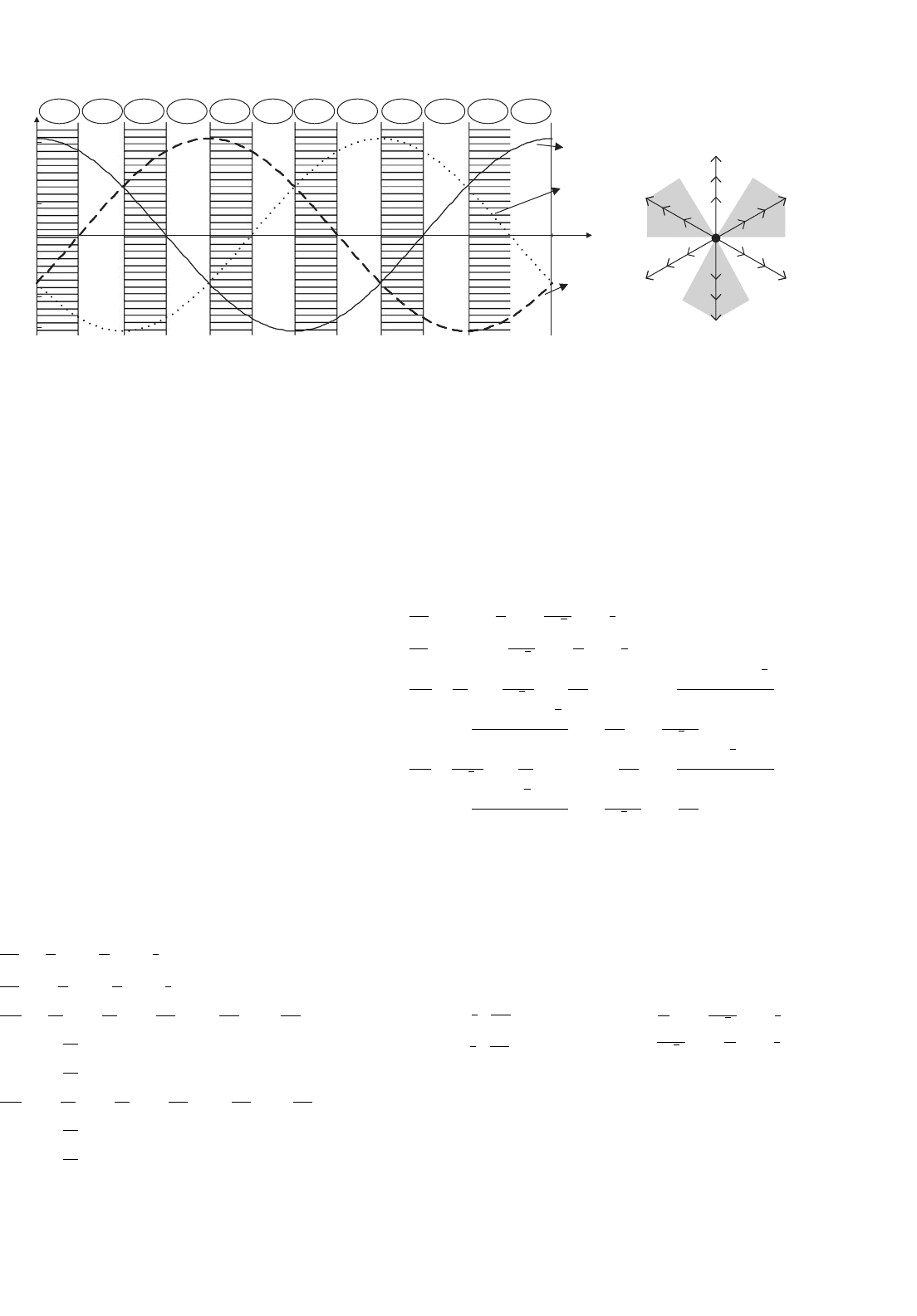
990 J. F. Silva and S. F. Pinto
−300
−200
−100
0
100
200
300
v
a
, v
b
, v
c
[V]
v
a
v
c
v
b
2π/ω
i
t [s]
V
i
12V
i
11V
i
10V
i
9V
i
8V
i
7V
i
6V
i
5V
i
4V
i
3V
i
2V
i
1
Sector V
i
1
(a) (b)
−8
+9
Z
−7
−6
+4
+5
+3
−1
−2
-9
+8
+7
−5
−4
+6
+2
+1
−3
2g
1g
5g
3g
4g6g
FIGURE 34.65 (a) Input voltages and their corresponding sector and (b) representation of the output voltage state-space vectors when the input
voltages are located at sector V
i
1.
According to Table 34.6, the 6 vectors of group I have fixed
amplitude but time varying phase, the 18 vectors of group
II have variable amplitude and vectors of group III are null.
Therefore, from the load viewpoint, the 18 highest amplitude
vectors (6 vectors from group I and 12 vectors from group II)
and one null vector are suitable to guarantee the sliding-mode
stability.
Therefore, if two three-level comparators (C
αβ
∈{−1, 0, 1})
are used to quantize the deviations of Eq. (34.178) from
zero, the nine output voltage error combinations (3
3
) are not
enough to guarantee the choice of all the 19 available vectors.
The extra vectors may be used to control the input power fac-
tor. As an example, if the output voltage error is quantized as
C
α
= 1, C
β
= 1, at sector V
i
1 (Fig. 34.65), the vectors −3, +1,
or 1g might be used to control the output voltage. The final
choice would depend on the input current error.
34.3.5.20 Input Power Factor Control
Assuming that the source is a balanced sinusoidal three-phase
voltage supply with frequency ω
i
, the switched state-space
model equations of the converter input filter is obtained in
abc coordinates.
di
l
a
dt
=
1
3l
v
bc
+
2
3l
v
ca
+
1
l
v
i
a
di
l
b
dt
=−
2
3l
v
bc
−
1
3l
v
ca
+
1
l
v
i
b
dv
bc
dt
=
1
3C
i
l
a
+
2
3C
i
l
b
−
1
3Cr
v
bc
+
1
3Cr
v
i
a
+
2
3Cr
v
i
b
−
1
3C
(
S
11
−S
31
+2S
12
−S
32
)
i
A
−
1
3C
(
S
21
−S
31
+2S
22
−S
32
)
i
B
dv
ca
dt
=−
2
3C
i
l
a
−
1
3C
i
l
b
−
1
3Cr
v
ca
−
2
3Cr
v
i
a
−
1
3Cr
v
i
b
+
1
3C
(
2S
11
−2S
31
+S
12
−S
32
)
i
A
+
1
3C
(
2S
21
−2S
31
+S
22
−S
32
)
i
B
(34.179)
To control the input power factor, a reference frame
synchronous with one of the input voltages v
i
a
, may be
used applying the Blondel–Park transformation to the matrix
converter switched state-space model (Eq. (34.179)), where
(ρ
i
dd
, ρ
i
dq
, ρ
i
qd
, ρ
i
qq
are functions of the ON/OFF states of the
nine S
kj
switches):
di
l
d
dt
=ω
i
i
lq
−
1
2l
v
c
d
−
1
2
√
3l
v
c
q
+
1
l
v
i
q
di
l
q
dt
=−ω
i
i
l
d
+
1
2
√
3l
v
c
d
−
1
2l
v
c
q
+
1
l
v
i
q
dv
c
d
dt
=
1
2C
i
l
d
−
1
2
√
3C
i
l
q
−
1
3Cr
v
c
d
+ω
i
v
cq
+
−ρ
i
dd
+
ρ
i
qd
/
√
3
2C
i
o
d
+
−ρ
i
dq
+
ρ
i
qq
/
√
3
2C
i
o
q
+
1
2Cr
v
i
d
−
1
2
√
3Cr
v
i
q
dv
c
q
dt
=
1
2
√
3C
i
l
d
+
1
2C
i
l
q
−ω
i
v
cd
−
1
3Cr
v
c
q
+
−
ρ
i
dd
/
√
3
−ρ
i
qd
2C
i
o
d
+
−
ρ
i
dq
/
√
3
−ρ
i
qq
2C
i
o
q
+
1
2
√
3Cr
v
i
d
+
1
2Cr
v
i
q
(34.180)
As a consequence, neglecting ripples, all the input variables
become time-invariant, allowing a better understanding of the
sliding-mode controller design, as well as the choice of the
most adequate state-space vector. Using this state-space model,
the input i
i
d
and i
i
q
currents are:
i
i
d
=i
l
d
+
l
r
di
l
d
dt
−ωi
l
q
i
i
q
=i
l
q
+
l
r
di
l
q
dt
+ωi
l
d
⇔
i
i
d
=i
l
d
−
1
2r
v
c
d
−
1
2
√
3r
v
c
q
+
1
r
v
i
d
i
i
q
=i
l
q
+
1
2
√
3r
v
c
d
−
1
2r
v
c
q
+
1
r
v
i
q
(34.181)
The input power factor controller should consider the
input–output power constraint (Eq. (34.182)) (the converter
losses and ripples are neglected), obtained as a function
of the input and output voltages and currents (the input
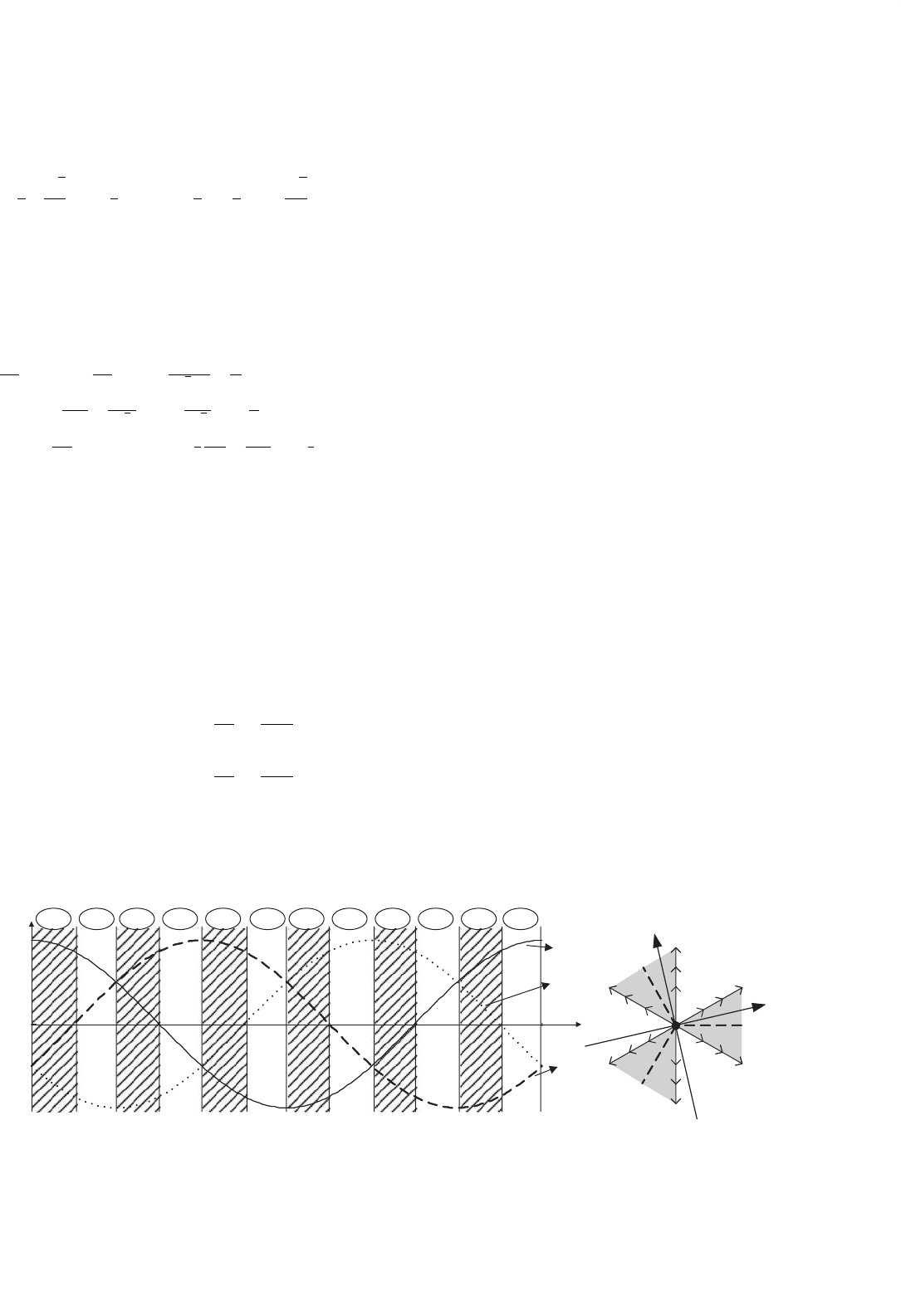
34 Control Methods for Switching Power Converters 991
voltage v
iq
is equal to zero in the chosen dq rotating frame).
The choice of one output voltage vector automatically defines
the instantaneous value of the input i
i
d
(t) current.
v
i
d
i
i
d
≈
1
3
&
√
3
2
v
o
d
+
1
2
v
o
q
'
i
o
d
+
1
3
&
−
1
2
v
o
d
+
√
3
2
v
o
q
'
i
o
q
(34.182)
Therefore, only the sliding surface associated to the i
i
q
(t)
current is needed, expressed as a function of the system state
variables and based on the state-space model determined in
Eq. (34.180):
di
i
q
dt
=−ωi
l
d
+
1
3Cr
i
l
q
+
−
1
6
√
3Cr
2
+
ω
2r
v
c
d
+
1
6Cr
2
+
ω
2
√
3r
v
c
q
+
1
2
√
3l
v
c
d
−
1
2l
v
c
q
+
1
3Cr
ρ
i
qd
i
o
d
+ρ
i
qq
i
o
q
1
r
dv
i
q
dt
−
1
3Cr
2
v
i
q
+
1
l
v
i
q
(34.183)
As the derivative of the input i
i
q
current depends directly on
the control variables ρ
i
qd
, ρ
i
qq
, the sliding function S
i
q
(e
i
q
, t)
will depend only on the input current error e
i
q
= i
i
qref
−i
i
q
.
S
i
q
(e
i
q
, t) = k
i
q
i
i
qref
−i
i
q
(34.184)
As the sliding-mode stability is guaranteed if S
αβ
(e
αβ
, t)
˙
S
αβ
(e
αβ
, t) < 0, the criterion to choose the state-space
vectors is:
S
i
q
(e
i
q
, t) > 0 ⇒
˙
S
i
q
(e
i
q
, t) < 0 ⇒
di
q
dt
>
di
q
ref
dt
⇒ i
i
q
↑
S
i
q
(e
i
q
, t) < 0 ⇒
˙
S
i
q
(e
i
q
, t) > 0 ⇒
di
q
dt
<
di
q
ref
dt
⇒ i
i
q
↓
(34.185)
Also, to choose the adequate input current vector it is nec-
essary: (a) to know the location of the output currents, as the
0
I
omax
i
A
, i
B
, i
C
[A]
i
A
i
C
i
B
−I
omax
I
o
12I
o
11I
o
10I
o
9I
o
8I
o
7I
o
6I
o
5I
o
1I
o
2I
o
3I
o
4
π
π/6/6 π/3/3 π/2/2 2π/3/3 5π/6/6 7π/6/6 4π/3/3 3π/2/2 5π/3/3 1111π/6/6 2ππ
(a)
Sector I
o
1
(b)
−5
+2
Z
−8
−1
+7
+4
+3
−9
−6
−2
+5
+8
−4
−7
+1
+6
+9
−3
1g
3g
2g
4g
6g
5g
d
q
π/6 π/3 π/2 2π/3 5π/6 7π/6 4π/3 3π/2 5π/3 11π/6 2ππ
FIGURE 34.66 (a) Output currents and their corresponding sector and (b) representation of input current state-space vectors, when the output
currents are located at sector I
o
1. The dq-axis is represented considering that the input voltages are located in zone V
i
1.
input currents depend on the output currents location (Table
34.6); (b) to know the dq frame location. As in the chosen
frame (synchronous with the v
i
a
input voltage), the dq-axis
location depends on the v
i
a
input voltage location, the sign
of the input current vector i
i
q
component can be determined
knowing the location of the input voltages and the location of
the output currents (Fig. 34.66).
Considering the previous example, at sector V
i
1 (Fig. 34.65),
for an error of C
α
= 1 and C
β
= 1, vectors −3, +1or1g
might be used to control the output voltage. When compared,
at sector I
o
1 (Fig. 34.66b), these three vectors have positive
i
d
components and, as a result, will have a similar effect on
the input i
d
current. However, they have a different effect on
the i
q
current: vector −3 has a positive i
q
component, vector
+1 has a negative i
q
component and vector 1g has a nearly
zero i
q
component. As a result, if the output voltage errors are
C
α
= 1 and C
β
= 1, at sectors V
i
1 and I
o
1, vector −3 should
be chosen if the input current error is quantized as C
iq
= 1
(Fig. 34.66b), vector +1 should be chosen if the input current
error is quantized as C
iq
=−1 and if the input current error
is C
iq
= 0, vector 1g or −3 might be used.
When the output voltage errors are quantized as zero
C
αβ
= 0, the null vectors of group III should be used only if the
input current error is C
iq
= 0. Otherwise (being C
i
q
= 0), the
lowest amplitude voltage vectors ({+2, −8, +5, −2, +8, −5}
at sector V
i
1 at Fig. 34.65b), that were not used to control the
output voltages, might be chosen to control the input i
q
cur-
rent as these vectors may have a strong influence on the input
i
q
current component (Fig. 34.66b).
To choose one of these six vectors, only the vectors located
as near as possible to the output voltages sector (Fig. 34.67) are
chosen (to minimize the output voltage ripple), and a five level
comparator is enough. As a result, there will be 9 × 5 = 45
error combinations to select 27 space vectors. Therefore, the
same vector may have to be used for more than one error
combination.
With this reasoning, it is possible to obtain Table 34.7 for
sector V
i
1, I
o
1, and V
o
1 and generalize it for all the other
sectors.
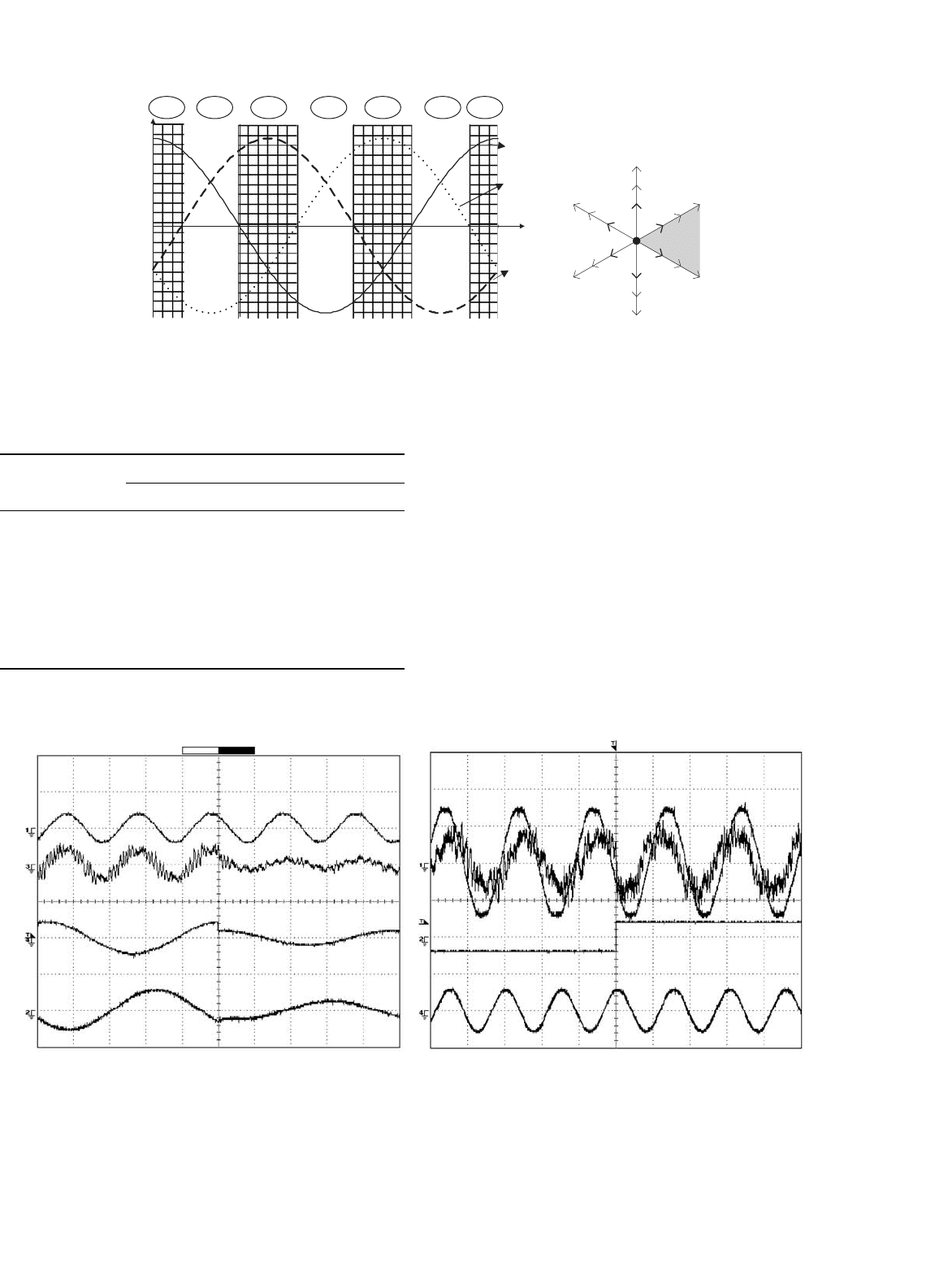
992 J. F. Silva and S. F. Pinto
(b)
v
AB
, v
BC
, v
CA
[V]
t [s]
v
AB
v
CA
v
BC
V
i
1V
i
6V
i
5V
i
4V
o
3V
o
2V
o
1
(a)
π
π/6/6 5π/6/6 7π/6/6 3π/2/2 1111π/6/6 2π
Sector V
o
1
−8
+5
−2
+8
−5
+2
π/2/2π/6 5π/6 7π/6 3π/2 11π/6 2ππ/2
FIGURE 34.67 (a) Output voltages and their corresponding sector and (b) representation of the lowest amplitude output voltage vectors, when the
input voltages are located at sector V
o
1.
TABLE 34.7 State-space vectors choice at sector V
i
1, I
o
1, and V
o
1
C
iq
C
α
C
β
−2 −10 1 2
−1 −1 +3 +3 +3 −1 −1
−105g +3 −6 −1 −1
−11−6 −6 −6 +43g
0 −1 6g −9 −9 +74g
00+8 +80−52
01−7 −7 +9 +9 +9
1 −1 −4 −4 +6 +6 +6
10+1 +1 +6 −3 −3
11+1 +11g −3 −3
Stopped
CH1 = 200 V
DC 100:1
CH = 500 mV
DC 1:1
CH3 =100 mV
DC 1:1
CH4 = 2 V
DC 10:1
2002/12/04 17:13:52
10 ms /div
Stopped
CH1 = 50 V
DC 100:1
CH 1= 5 V
DC 10:1
CH3= 50 mV
DC 1:1
CH4= 500 V
DC 1:1
2002/12/11 17:19:25
10 ms/div
(10 ms/div)
NORM:100 kS/s
NORM:20kS/s
(a) (b)
FIGURE 34.68 Dynamic responses obtained with a three-phase load: (a) output reference voltage step (R = 7 , L = 15 mH, f
o
= 20 Hz): input
voltage v
i
a
(t) (CH1), input current i
i
a
(t) (CH3), output reference voltage v
BC
ref
(t) (CH4), and output current i
A
(t) (CH2) and (b) input reference
current i
i
qref
(t) step: input voltage v
i
a
(t) (CH1), input current i
i
a
(t) (CH3), input reference current i
i
qref
(t) (CH2), and output current i
A
(t) (CH4).
The experimental results shown in (Fig. 34.68) were
obtained with a low-power prototype (1 kW), with two three-
level comparators and one five-level comparator, associated to
an EPROM lookup table. The transistors IGBT were switched
at frequencies near 10 kHz.
The results show the response to a step on the output
voltage reference (Fig. 34.68a) and on the input reference cur-
rent (Fig. 34.68b), for a three-phase output load (R = 7 ,
L = 15 mH), with k
αβ
= 100 and k
iq
= 2. These results
show that the matrix converter may operate with a near unity
input power factor (Fig. 34.68a – f
o
= 20 Hz), or with lead/lag
power factor (Fig. 34.68b), guaranteeing very low ripple on the
output currents, a good tracking capability and fast transient
response times.
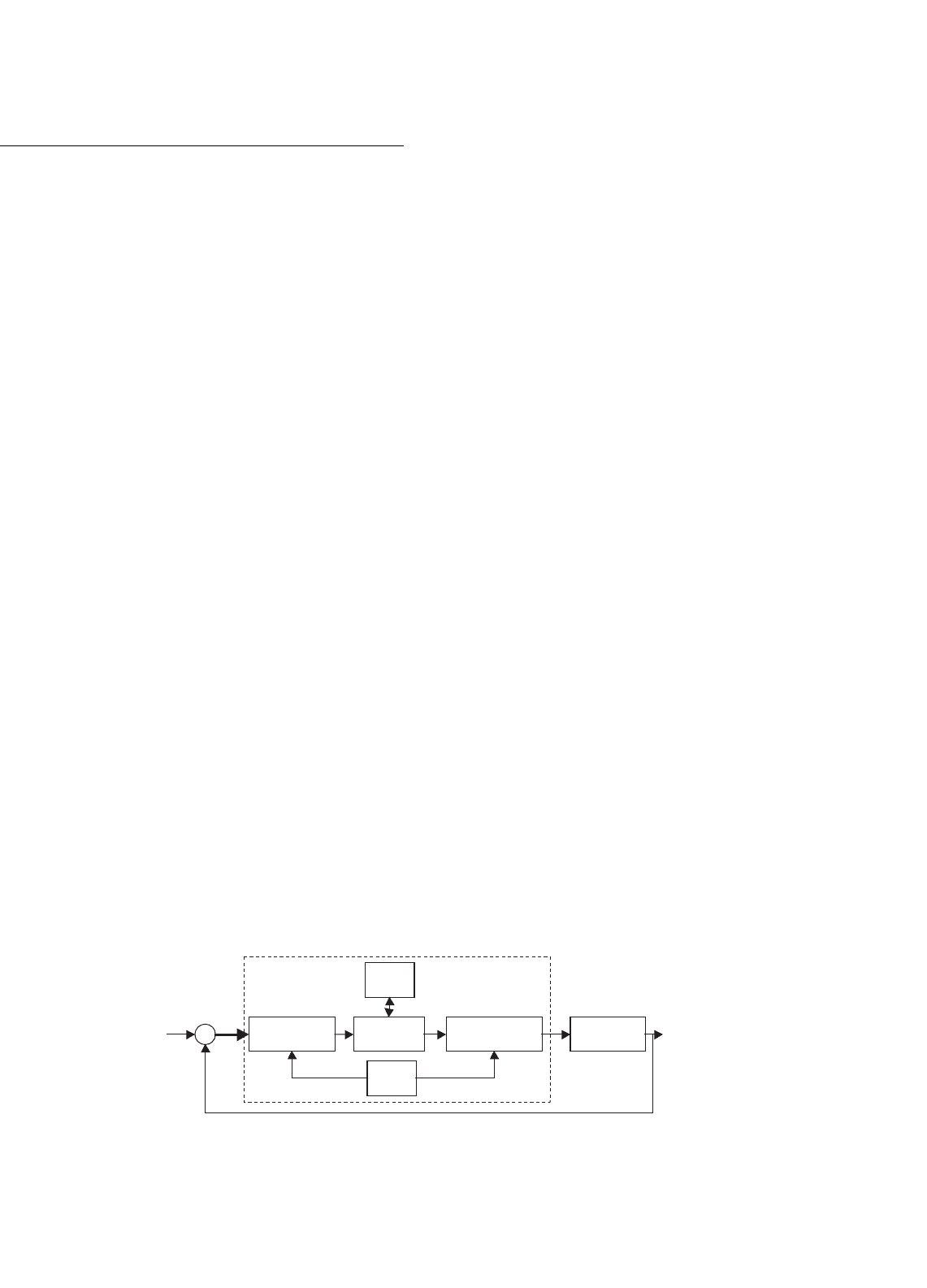
34 Control Methods for Switching Power Converters 993
34.4 Fuzzy Logic Control of Switching
Converters
34.4.1 Introduction
Fuzzy logic control is a heuristic approach that easily embeds
the knowledge and key elements of human thinking in
the design of nonlinear controllers [19–21]. Qualitative and
heuristic considerations, which cannot be handled by conven-
tional control theory, can be used for control purposes in a
systematic form, and applying fuzzy control concepts [22].
Fuzzy logic control does not need an accurate mathematical
model, can work with imprecise inputs, can handle nonlinear-
ity, and can present disturbance insensitivity greater than the
most nonlinear controllers. Fuzzy logic controllers usually out-
perform other controllers in complex, nonlinear, or undefined
systems for which a good practical knowledge exists.
Fuzzy logic controllers are based on fuzzy sets, i.e. classes of
objects in which the transition from membership to nonmem-
bership is smooth rather than abrupt. Therefore, boundaries
of fuzzy sets can be vague and ambiguous, making them useful
for approximation models.
The first step in the fuzzy controller synthesis procedure
is to define the input and output variables of the fuzzy con-
troller. This is done accordingly with the expected function
of the controller. There are no general rules to select those
variables, although typically the variables chosen are the states
of the controlled system, their errors, error variation and/or
error accumulation. In switching power converters, the fuzzy
controller input variables are commonly the output voltage
or current error, and/or the variation or accumulation of
this error. The output variables u(k) of the fuzzy controller
can define the converter duty cycle (Fig. 34.60), or a refer-
ence current to be applied in an inner current-mode PI or a
sliding-mode controller.
The fuzzy controller rules are usually formulated in linguis-
tic terms. Thus, the use of linguistic variables and fuzzy sets
implies the fuzzification procedure, i.e. the mapping of the
input variables into suitable linguistics values.
Rule evaluation or decision-making infers, using an infer-
ence engine, the fuzzy control action from the knowledge of
the fuzzy rules and the linguistic variable definition.
Fuzzification Defuzzification
Inference
Engine
Rule
Base
Data
Base
y(k)
Power
Converter
FUZZY
CONTROLLER
u(k)
r(k)
_
+
+
e(k)
e‘(k)
FIGURE 34.69 Structure of a fuzzy logic controller.
The output of a fuzzy controller is a fuzzy set, and thus it
is necessary to perform a defuzzification procedure, i.e. the
conversion of the inferred fuzzy result to a nonfuzzy (crisp)
control action, that better represents the fuzzy one. This last
step obtains the crisp value for the controller output u(k)
(Fig. 34.69).
These steps can be implemented on-line or off-line. On-line
implementation, useful if an adaptive controller is intended,
performs real-time inference to obtain the controller output
and needs a fast enough processor. Off-line implementation
employs a lookup table built according to the set of all pos-
sible combinations of input variables. To obtain this lookup
table, the input values in a quantified range are converted
(fuzzification) into fuzzy variables (linguistic). The fuzzy set
output, obtained by the inference or decision-making engine
according to linguistic control rules (designed by the knowl-
edge expert), is then, converted into numeric controller output
values (defuzzification). The table contains the output for all
the combinations of quantified input entries. Off-line pro-
cess can actually reduce the controller actuation time since
the only effort is limited to consulting the table at each
iteration.
This section presents the main steps for the implementation
of a fuzzy controller suitable for switching converter control.
A meaningful example is provided.
34.4.2 Fuzzy Logic Controller Synthesis
Fuzzy logic controllers consider neither the parameters of the
switching converter or their fluctuations, nor the operating
conditions, but only the experimental knowledge of the switch-
ing converter dynamics. In this way, such a controller can be
used with a wide diversity of switching converters implying
only small modifications. The necessary fuzzy rules are simply
obtained considering roughly the knowledge of the switching
converter dynamic behavior.
34.4.2.1 Fuzzification
Assume, as fuzzy controller input variables, an output volt-
age (or current) error, and the variation of this error. For
the output, assume a signal u(k), the control input of the
converter.
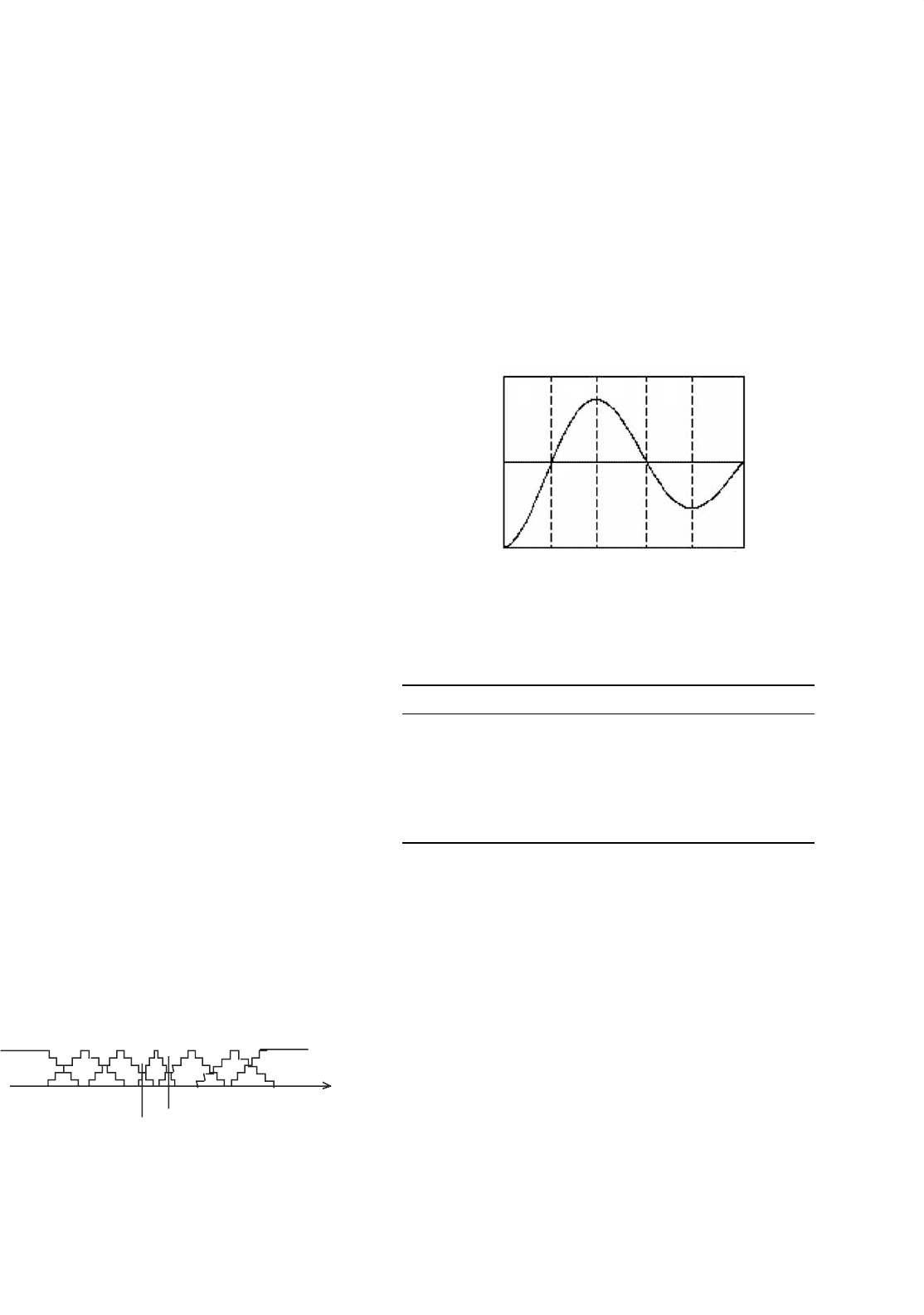
994 J. F. Silva and S. F. Pinto
A. Quantization Levels Consider the reference r(k)ofthe
converter output kth sample, y(k). The tracking error e(k)
is e(k) = r(k) − y(k) and the output error change
e
(k),
between the samples k and k − 1, is determined by
e
(k) =
e(k) − e(k − 1).
These variables and the fuzzy controller output u(k), usu-
ally ranging from −10 to 10 V, can be quantified in m levels
{−(m −1)/2, +(m −1)/2}. For off-line implementation, m
sets a compromise between the finite length of a lookup table
and the required precision.
B. Linguistic Variables and Fuzzy Sets The fuzzy sets for
x
e
, the linguistic variable corresponding to the error e(k), for
x
e
, the linguistic variable corresponding to the error variation
e
(k), and for x
u
the linguistic variable of the fuzzy controller
output u(k), are usually defined as positive big (PB), positive
medium (PM ), positive small (PS), zero (ZE), negative small
(NS), negative medium (NM), and negative big (NB), instead
of having numerical values.
In most cases, the use of these seven fuzzy sets is the best
compromise between accuracy and computational task.
C. Membership Functions A fuzzy subset, for example
S
i
(S
i
= (NB, NM, NS, ZE, PS, PM, or PB)) of a universe E,
collection of e(k) values denoted generically by {e}, is charac-
terized by a membership function µ
Si
: E →[0,1], associating
with each element e of universe E, a number µ
Si
(e)inthe
interval [0,1], which represents the grade of membership of
e to E. Therefore, each variable is assigned a membership
grade to each fuzzy set, based on a corresponding member-
ship function (Fig. 34.70). Considering the m quantization
levels, the membership function µ
Si
(e) of the element e in the
universe of discourse E, may take one of the discrete values
included in µ
Si
(e) ∈{0; 0.2; 0.4; 0.6; 0.8; 1; 0.8; 0.6; 0.4; 0.2; 0}.
Membership functions are stored in the database (Fig. 34.69).
Considering e(k) = 2 and
e
(k) =−3, taking into account
the staircase-like membership functions shown in Fig. 34.70,
it can be said that x
e
is PS and also ZE, being equally PS and
ZE. Also, x
e
is NS and ZE, being less ZE than NS.
D. Linguistic Control Rules The generic linguistic control
rule has the following form: “IF x
e
(k) is membership of the
set S
i
= (NB, NM, NS, ZE, PS, PM, or PB) AND x
e
(k)is
ZE PS PM PBNSNB NM
0 5 10 15 20−20 −15 −10 −5
x
e
x
∆e
x
u
x
e
= 2
0
1
x
∆e
= −3
FIGURE 34.70 Membership functions in the universe of discourse.
membership of the set S
j
= (NB, NM, NS, ZE, PS, PM, or
PB), THEN the output control variable is membership of the
set S
u
= (NB, NM, NS, ZE, PS, PM, or PB).”
Usually, the rules are obtained considering the most com-
mon dynamic behavior of switching converters, the second-
order system with damped oscillating response (Fig. 34.71).
Analyzing the error and its variation, together with the rough
linguistic knowledge of the needed control input, an expert
can obtain linguistic control rules such as the ones displayed
in Table 34.8. For example, at point 6 of Fig. 34.71 the rule is
“if x
e
(k)isNMANDx
e
(k) is ZE, THEN x
u
(k + 1) should
be NM.”
θ(t)
s1 s2 s3 s4
5
7
8
0
0
t
6
FIGURE 34.71 Reference dynamic model of switching converters:
second-order damped oscillating error response.
TABLE 34.8 Linguistic control rules
x
e
(k)x
e
(k)NB NMNS ZE PS PMPB
NB NB NB NB NM NM PS PM
NM NB NB NM NS NM PM PB
NS NB NB NM NS NS PM PB
ZE NB NM NS ZE PS PM PB
PS NB NM PS PS PM PB PB
PM NB NM PM PS PM PB PB
PB NM NS PM PM PB PB PB
Table 34.8, for example, states that:
IF x
e
(k)isNBANDx
e
(k) is NB, THEN x
u
(k + 1) must be
NB, or
IF x
e
(k)isPSANDx
e
(k) is NS, THEN x
u
(k + 1) must be
NS, or
IF x
e
(k)is PS AND x
e
(k) is ZE, THEN x
u
(k + 1) must be
PS, or
IF x
e
(k)isZEANDx
e
(k) is NS, THEN x
u
(k + 1) must be
NS, or
IF x
e
(k)isZEANDx
e
(k) is ZE, THEN x
u
(k + 1) must be
ZE, or
IF…
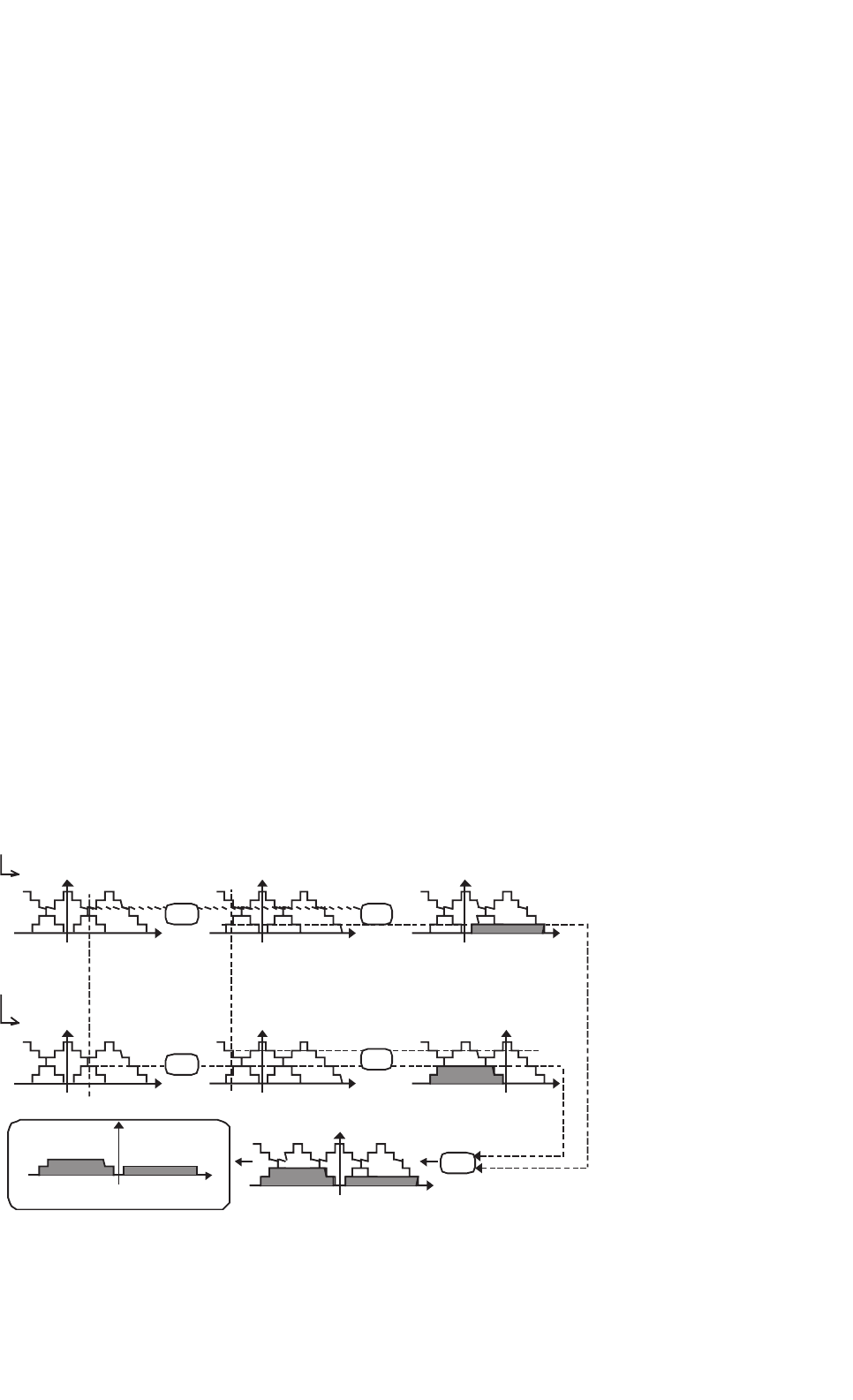
34 Control Methods for Switching Power Converters 995
These rules (rule base) alone do not allow the definition of the
control output, as several of them may apply at the same time.
34.4.2.2 Inference Engine
The result of a fuzzy control algorithm can be obtained using
the control rules of Table 34.8, the membership functions, and
an inference engine. In fact, any quantified value for e(k) and
e
(k) is often included into two linguistic variables. With the
membership functions used, and knowing that the controller
considers e(k) and
e
(k), the control decision generically
must be taken according to four linguistic control rules.
To obtain the corresponding fuzzy set, the min–max infer-
ence method can be used. The minimum operator describes
the “AND” present in each of the four rules, that is, it calculates
the minimum between the discrete value of the membership
function µ
Si
(x
e
(k)) and the discrete value of the member-
ship function µ
Sj
(x
e
(k)). The “THEN” statement links this
minimum to the membership function of the output variable.
The membership function of the output variable will there-
fore include trapezoids limited by the segment min(µ
Si
(x
e
(k)),
µ
Sj
(x
e
(k))).
The OR operator linking the different rules is implemented
by calculating the maximum of all the (usually four) rules.
This mechanism to obtain the resulting membership function
of the output variable is represented in Fig. 34.72.
34.4.2.3 Defuzzification
As shown, the inference method provides a resulting mem-
bership function µ
Sr
(x
u
(k)), for the output fuzzy variable x
u
AND
0,6
0,2
min
THEN
Rule 1:
IF x
e
is Positive Small AND x∆
e
is Zero THEN result is Positive Small
Rule 2:
IF x
e
is Zero
AND x∆e is Negative Small THEN result is Negative Small
x
e
= 3
x∆
e
= −4
max
Resulting membership function
05−5
1
PS
ZE
NS PS
ZE
NS
min
PS
ZE
NS
AND
0,8
0,4
min
THEN
0,4
result
PS
ZE
NS PS
ZE
NS
min
ZENS
0,2
NM
PSZENSNM
0,2
0,4
FIGURE 34.72 Application of the min–max operator to obtain the output membership function.
(Fig. 34.72). Using a defuzzification process, this final mem-
bership function, obtained by combining all the membership
functions, as a consequence of each rule, is then converted into
a numerical value, called u(k). The defuzzification strategy can
be the center of area (COA) method. This method generates
one output value u(k), which is the abscissa of the gravity cen-
ter of the resulting membership function area, given by the
following relation:
u(k) =
&
m
i=1
µ
Sr
(x
u
(k))x
u
(k)
'
%
m
i=1
µ
Sr
(x
u
(k)) (34.186)
This method provides good results for output control.
Indeed, for a weak variation of e(k) and
e
(k), the center
of the area will move just a little, and so does the controller
output value. By comparison, the alternative defuzzification
method, mean of maximum strategy (MOM) is advantageous
for fast response, but it causes a greater steady-state error and
overshoot (considering no perturbations).
34.4.2.4 Lookup Table Construction
Using the rules given in Table 34.8, the min–max inference
procedure and COA defuzzification, all the controller out-
put values for all quantified e(k) and
e
(k), can be stored
in an array to serve as the decision-lookup table. This lookup
table usually has a three-dimensional representation similar
to Fig. 34.73. A microprocessor-based control algorithm just
picks up output values from the lookup table.
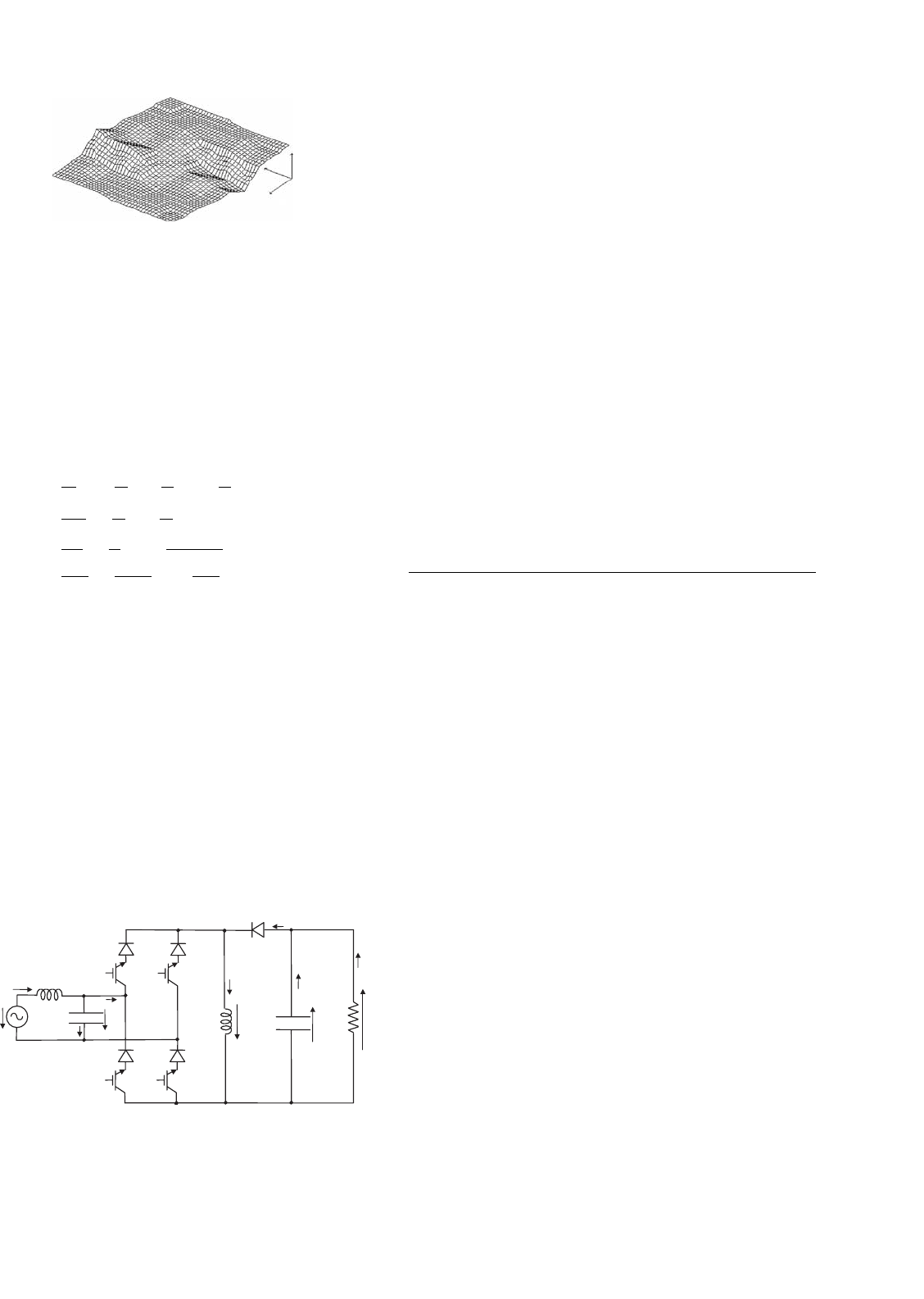
996 J. F. Silva and S. F. Pinto
∆
e
s (k)
e (k)
u (k)
FIGURE 34.73 Three-dimensional view of the lookup table.
34.4.3 Example: Near Unity Power Factor
Buck–Boost Rectifier
EXAMPLE 34.18 Fuzzy logic control of unity power
factor buck–boost rectifiers
Consider the near unity power factor buck–boost recti-
fier of Fig. 34.74.
The switched state-space model of this converter can
be written:
di
s
dt
=−
R
f
L
f
i
s
−
1
L
f
v
C
f
+
1
L
f
v
s
dv
C
f
dt
=
1
C
f
i
s
−
γ
p
C
f
i
L
o
di
L
o
dt
=
γ
p
L
o
v
C
f
−
γ
(
1−
|
γ
p
|
)
L
o
V
C
o
dV
C
o
dt
=
1−
|
γ
p
|
C
o
i
L
o
−
1
R
o
C
o
V
o
(34.187)
where γ
p
=
1, (switch 1 and 4 are ON ) and
(switch 2 and 3 are OFF)
0, all switches are OFF
−1, (switch 2 and 3 are ON ) and
(switch 1 and 4 are OFF)
and γ =
*
1, i
L
o
> 0
0, i
L
o
≤ 0
For comparison purposes, a PI output voltage con-
troller is designed considering that a current-mode
PWM modulator enforces the reference value for the
L
o
Co
D1
IGBT1
D3
IGBT3
IGBT2
D2
IGBT4
D4
V
o
R
o
i
s
v
s
L
f
, R
f
C
f
Do
i
C
f
i
rec
i
Lo
i
Co
i
Do
i
o
v
Lo
V
Co
v
C
f
FIGURE 34.74 Unity power factor buck–boost rectifier with four
IGBTs.
i
s
current (which usually exhibits a fast dynamics com-
pared with the dynamics of V
C
o
). A first-order model,
similar to Eq. (34.146) is obtained. The PI gains are simi-
lar to Eq. (34.116) and load-dependent (K
p
= C
o
/(2T
d
),
K
i
= 1/(2T
d
R
o
)).
A fuzzy controller is obtained considering the
approach outlined, with seven membership functions
for the output voltage error, five for its change, and
three membership functions for the output. The linguis-
tic control rules are obtained as the ones depicted in
Table 34.8 and the lookup table gives a mapping sim-
ilar to Fig. 34.73. Performances obtained for the step
response show a fuzzy controlled rectifier behavior close
to the PI behavior. The advantages of the fuzzy con-
troller emerge for perturbed loads or power supplies,
where the low sensitivity of the fuzzy controller to sys-
tem parameters is clearly seen (Fig. 34.75). Therefore,
the fuzzy controllers can be advantageous for switching
converters with changing loads, power supply voltages,
and other external disturbances.
34.5 Conclusions
Control techniques for switching converters were reviewed.
Linear controllers based on state-space averaged models or
circuits are well established and suitable for the application
of linear systems control theory. Obtained linear controllers
are useful, if the converter operating point is almost constant
and the disturbances are not relevant. For changing operat-
ing points and strong disturbances, linear controllers can be
enhanced with nonlinear, antiwindup, soft-start, or saturation
techniques. Current-mode control will also help to overcome
the main drawbacks of linear controllers.
Sliding mode is a nonlinear approach well adapted for the
variable structure of the switching converters. The critical
problem of obtaining the correct sliding surface was high-
lighted, and examples were given. The sliding-mode control
law allows the implementation of the switching converter
controller, and the switching law gives the PWM modula-
tor. The system variables to be measured and fed back are
identified. The obtained reduced-order dynamics is not depen-
dent on system parameters or power supply (as long as it
is high enough), presents no steady-state errors, and has a
faster response speed (compared with linear controllers), as
the system order is reduced and non-idealities are elimi-
nated. Should the measure of the state variables be difficult,
state observers may be used, with steady-state errors eas-
ily corrected. Sliding-mode controllers provide robustness
against bounded disturbances and an elegant way to obtain
the controller and modulator, using just the same theo-
retical approach. Fixed-frequency operation was addressed
and solved, together with the short-circuit-proof operation.
